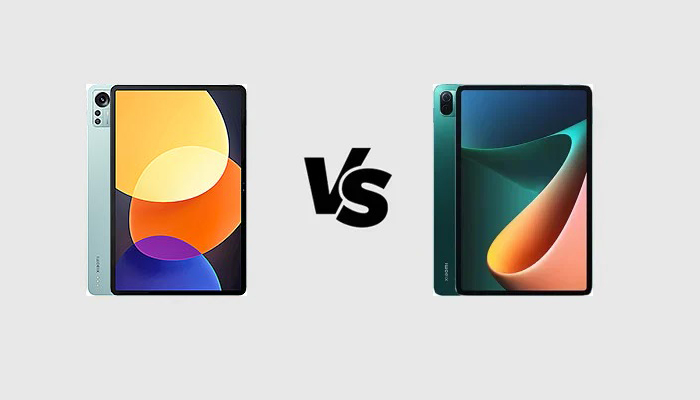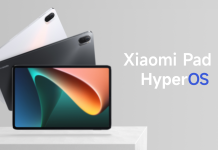Xiaomi just launched its biggest tablet: the Xiaomi Pad 5 Pro 12.4. It does not differ so much from the Pro variant launched last year with a smaller display, but the change in dimensions is very important for those people who search for a good tablet for productivity. However, given the similarities between their spec sheets, we think it is not worth making a comparison between the two Pro tablets. Instead, we chose the vanilla version because it is very different and we believe it is very interesting to understand which of these tablets offers the highest value for money. So this is a comparison between the main specifications of the Xiaomi Pad 5 Pro 12.4 and the vanilla Xiaomi Pad 5. After this, you will know which one to buy if you are an average user and you were looking for a good new tablet.

Xiaomi Pad 5 Pro 12.4 vs Xiaomi Mi Pad 5
| Xiaomi Pad 5 Pro 12.4 | Xiaomi Mi Pad 5 | |
|---|---|---|
| DIMENSIONS AND WEIGHT | 285 x 185.2 x 6.7 mm, 620 grams | 254.7 x 166.3 x 6.9 mm, 511 g |
| DISPLAY | 12.4 inches, 1600 x 2560p (Quad HD+), IPS LCD | 11 inches, 1600 x 2560p (Quad HD+), IPS LCD |
| PROCESSOR | Qualcomm Snapdragon 870, octa-core 3.2 GHz | Qualcomm Snapdragon 860, octa-core 2.96 GHz |
| MEMORY | 6 GB RAM, 128 GB – 8 GB RAM, 256 GB – 12 GB RAM, 512 GB | 6 GB RAM, 128 GB – 6 GB RAM, 256 GB |
| SOFTWARE | Android 12, MIUI Pad | Android 11, MIUI |
| CONNECTIVITY | Wi-Fi 802.11 a/b/g/n/ac/ax, Bluetooth 5.2, GPS | Wi-Fi 802.11 a/b/g/n/ac, Bluetooth 5.0, GPS |
| CAMERA | Dual 50 + 2 MP f/1.8 + f/2.4 20 MP f/2.2 front camera |
Single 13 MP f/2.0 8 MP f/2.0 front camera |
| BATTERY | 10,000 mAh, fast charging 67W | 8720 mAh, fast charging 33W |
| ADDITIONAL FEATURES | Stylus support, keyboard support, MIUI Pad | Pen support, keyboard support |
Design
Despite these tablets belonging to the same series (even though the latest one made its debut a year after the predecessor), they come with very different designs due to their different camera modules. The Xiaomi Pad 5 has a similar camera module to the Xiaomi Mi 11, while the Xiaomi Pad 5 Pro 12.4 has a similar design to the Xiaomi 12. But they share several things in common: first of all, they are very thin (the Pro variant is thinner with just 6.7 mm against 6.9 mm). Further, they have a very high screen to body ratio with the display covering more than 80 percent of the front glass. Given that the Xiaomi Pad Pro 12.4 has a wider display, it is way bigger than the vanilla version, so it will be more comfortable to use but harder to transport.
Display
The displays of these two tablets have almost the same specifications but they differ in terms of dimensions. If you are a productivity user, then you may prefer the Xiaomi Pad 5 Pro 12.4 because of its wide display. All the most important tablets for work and productivity have a display with a diagonal above 12 inches because it is easier to work with the most advanced apps and to leverage the user interfaces specifically made for tablets. Further, besides supporting a pen, the Pro variant supports a keyboard. The main display specifications are the same and they include a Quad HD+ resolution of 1600 x 2560 pixels, a 120 Hz refresh rate, HDR10 certification, and Dolby Vision support. Note that these are IPS panels, so do not expect those outstanding colors you can currently find on flagship Android phones. The Xiaomi Pad 5 Pro 12.4 is the only one protected by Gorilla Glass 3, so it should provide a more resistant front glass.
Specs & Software
The chipset found on the Xiaomi Pad 5 Pro 12.4 is actually more powerful than the one found on the vanilla version. It is a Snapdragon 870 mobile platform by Qualcomm built with a 7 nm production process and sporting an octa-core architecture. The processor is composed of a Kryo 585 CPU running at a max frequency of 3.2 GHz, three Kryo 585 CPUs running at a frequency of 2.42 GHz, four Kryo 585 CPUs running at 1.8 GHz, and an Adreno 650 CPU. The SoC is paired with up to 12 GB of RAM and up to 256 GB of native storage (UFS 3.1, to be accurate). The vanilla Xiaomi Pad 5 has a Snapdragon 860 chipset paired with just 6 GB of RAM: there is no way for it to compete in terms of performance. Further, the Pro variant offers something more when it comes to the software, thanks to the MIUI Pad 13 based on Android 12: not only a more recent software version but also a version customized for tablets.
Camera
The Xiaomi Pad 5 Pro 12.4 also brings a few improvements to the camera department. It is equipped with a better 50 MP main camera paired with a 2 MP depth sensor, while on the front side, it comes with a 20 MP selfie shooter. It is a definitely better camera setup than the Xiaomi Pad 5: the vanilla version comes with a disappointing 13 MP main sensor and an 8 MP selfie snapper. The Pro variant does not come with a high-end camera, but it is more than sufficient.
- Read More: Xiaomi Mi Pad 5 & Mi Pad 5 Pro Official: 11″, 120Hz refresh rate, 5G, MIUI for Pad & more!
Battery
Given that it is bigger, the Xiaomi Pad 5 Pro 12.4 is also equipped with a bigger battery. Thanks to a capacity of 10,000 mAh, it is one of the best tablets in terms of battery life. Further, it charges quicker with 67W fast charging. The vanilla version has a smaller 8720 mAh battery with 33W fast charging, but it still provides good battery life and good charging speeds.
Price
The starting price of the Xiaomi Pad 5 roughly translates to €350/$361, while the Xiaomi Pad 5 Pro 12.4 starts from €402/$415. Note that the Pro variant is only available in the Chinese market, at least for now, while the vanilla version is available globally. Which one would you pick?
Xiaomi Pad 5 Pro vs Xiaomi Mi Pad 5: PRO and CONS
Xiaomi Pad 5 Pro
PRO
- Better chipset
- Wider display
- Superior camera
- Bigger battery
- Faster charging
- Up to 512 GB of storage
CONS
- Dimensions
- Price
Xiaomi Mi Pad 5
PRO
- More affordable
- More compact
- Wider availability
CONS
- Inferior hardware
- Inferior camera
RELATED
- Redmi K40 vs Motorola Edge S: Specs Comparison
- Redmi K40 vs K40 Pro vs K40 Pro+: Specs Comparison
- Black Shark 5 Pro vs Black Shark 5 vs Black Shark 5 RS: Specs Comparison
- Realme GT Master Explorer vs OnePlus Nord 2: Specs Comparison







